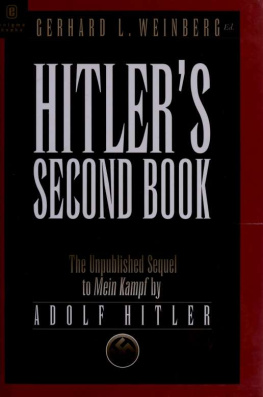
The author and publisher have provided this e-book to you for your personal use only. You may not make this e-book publicly available in any way. Copyright infringement is against the law. If you believe the copy of this e-book you are reading infringes on the authors copyright, please notify the publisher at: us.macmillanusa.com/piracy.
Contents
Introduction:
One:
Two:
Three:
Four:
Five:
Six:
Seven:
INTRODUCTION
An Entry from a Journal
In 1937 Samuel Beckett took an extended trip to Germany. As he was walking through the streets of Regensburg, Bavaria, on March 3, a sign above the portal of the Dominican church caught his attention. He noted in his travel diary: Walk away past Dominikanerkirche, that I dont look at, except to see on northern door notice Grss Gott crossed out+replaced by Heil Hitler!!!
This observation, part of the flotsam of names and dates with which Beckett filled his journal, became one of the many straws he collected so as to retain the chaotic and incoherent aspects of his experiences in the hope that he might one day understand them. Hostile to unifying theories of any sorthe found historical determinism particularly repellentBeckett simply marked the importance of his observation through his use of punctuation. What he saw in Regensburg was added to the impressions he had taken away from interactions with Germans in Hamburg, Berlin, and elsewhere in his travels, where he had already noted the ubiquity of the Hitler salute. Even bathroom attendants greet you with Heil Hitler. But this note, ending in three exclamation points, differs from the others with their neutral, phlegmatic tone. The three exclamation points mark the alienating and confounding nature of what caught the travelers eye that day in Regensburgthe replacement of the word God with the name of the Fhrer. Ending in this way, Becketts observation reads like a note to himself, a reminder to reflect on what he had seen.
But Beckett never returned to the topic. In April 1937, a month after his visit to Regensburg, he left Germany to take up permanent residence in France, and the astonishment he expressed at the incomprehensible subversion of language that was the Hitler greeting disappeared into the confused memories of a young man in search of an aesthetic identity and literary voice of his own. Interestingly, a few years later, Beckett would make his name through works that express the breakdown of human relationstheir central themeas a breakdown of language. The present book returns to those three exclamation points with which Beckett registered his intuitive horror at the rupture of meaning he sensed in the Nazi greeting. That, then, is the subject of this inquiry: how Germans greeted one another and what happened when their traditional ways of greetings were replaced by the Hitler salute.
CHAPTER ONE
Shaping the Beginning
If we want to know how a society creates mutual understanding among its members, publicly staged displays of collective goodwill can tell us little. It is not the candlelight vigil, but rather the small, everyday gesturesour forms of greetings and address, the seemingly inconsequential Hello, how are you? proffered by one person to anotherthat provide the most information about how people communicate, where they draw their boundaries, and what they choose to disclose or conceal.
When we greet someone, we turn our attention to that person and offer him or her access to ourselves in a particular way. Seen from this angle, a greeting is an initial and symbolic gift to the person to whom it is addressed. A gift in its most abstract form, it nevertheless imposes a predetermined series of concrete obligations on both partiesthe greeter and the person being greeted. The greeting is the first step in a triadic sequence of offer, acceptance, and response. The briefest of gestures within the infinitely variable choreography of human encounters, the greeting opens a door between the greeter and the person greeted and assigns them specific social roles; it creates a mutual present for them and gives them access to each others past and to a possible common future. Every greeting, even if rejected, reflects how the participants see themselves and their relationship.
Rules and formulas of salutation can change over time and often vary from region to region. A Shakespearean greeting like Good morrow, sir! would bring an incredulous smile to the lips of a twenty-first-century American, or even Briton, just as a typical Texan Howdy might sound odd on the streets of New York City. In Germany, regional differences in forms of greeting are every bit as marked, if not more so. Gr Gott, the effacement of which from above the doorway of the Dominican church in Regensburg so shocked Samuel Beckett, or the Bavarian greeting of Servus would both seem out of place in Hamburg, whereas Moin-Moin, universal among the residents of Germanys northern coastal regions, or the laconic and somewhat fatalistic EiEi gude wie of the Hessians would cause astonishment outside their respective territories. Greetings are always subject to concrete norms, and every greeting reflects the degree of civility, formality, or dignity a particular community confers on social exchange. But greetings also embody a universal social fact, insofar as they entail a fixed set of expectations that apply to every member of society, without exception. As Jos Ortega y Gasset has said, the greeting is not itself a positive act, it is not a usage with a useful content of its own, it is the usage that symbolizes all others, it is the usage of usages.
Greetings provide an initial structure for human interaction; this is their privileged function. Together with rituals of taking leave, greetings moderate and frame our encounters. They define the rules and context for communication, and therein lies their central importance. Everyone recognizes the difference between a casual greeting among friends and a formal greeting at an official ceremony.
Greetings are often considered empty rituals that people perform unconsciously in order to get to what comes afterwardthe ends to be achieved once the initial formalities have been dispensed with. But greetings are also signifying structures: they carry their own meanings, set their own preconditions, and entail to some extent their own outcomes. Greetings can be a pure exchange (to use Georg Simmels term) or a means to an end, that is, communication; they allow us to reveal ourselves or to hide; they can bring people together or keep them apart. This double-sided nature of the greeting, together with the multitude of forms the greeting can take, make it a particularly interesting topic for evolutionary theory and the ethics of civilizations. The greeting is part of the natural history of social encounters, offering fascinating insights into the various ways members of the same species enter into contact with one another. One might think that greetings are too trivial to affect social institutions in any significant way, yet their importance should not be underestimated. It is next to impossible to conceive of a society that could do without formalized greetings or survive without those gestures people use to initiate contact with others.
* * *
A NY REFLECTION on behavior, manners, and interpersonal relationships within a specific society must begin with the question of how greetings are used, and not only in public spacesin schools, in the workplace, and at official eventsbut also privately, among friends and family. The issue of how members of a culture greet one another automatically arises whenever we consider the question of normative integration within complex societies. What holds a society together? is the modern version of the venerable question of what makes social order possible. Every society invents its own rules governing how people should introduce themselves and take leave of one another. Often the sequence of who should greet whom first is preordained: people of lesser status before their superiors, the young before the old, men before women, new arrivals before those already present.
Next page











